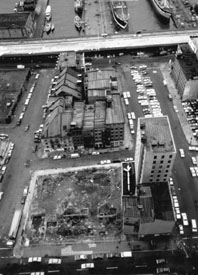

 | Page 629 |  |
Theoretical fragmentation and the complexity caused by the decline of processualism and the rise and opening decline of postprocessualism have been paralleled by an equally complex sequential and overlapping series of occupational housing for the discipline. CRM rapidly elevated historical archaeology into the most commonly practiced and massively funded type of archaeology in North America, far surpassing prehistoric archaeology, but the primacy of New World prehistory and other traditional forms of archaeology artificially persevere in universities and the museum world. Historical archaeology is still not taught in the majority of American and Canadian universities, and the field is denied the true status it should have because of its professional size and theoretical importance.

Excavations of the Telco Block Site in the South Street Seaport Historic District in New York City in 1981, directed by Diana Rockman [Wall], produced both colonial and nineteenth–century deposits. This site’s legal and environmental setting—the dense urban section of Lower Manhattan and CRM funding under federal laws—is typical of many large historic projects after 1970.
(David Barnet)
Equally potential internal strains caused by the continuing academic intellectual leadership within historical archaeology have been, at least to the present, defused by the Society for Historical Archaeology’s long tradition of drawing researchers equally from governmental, and now CRM, sources to fill its highest offices and the organization’s successful appeal to all historical archaeologists irrespective of employment.
By the year 2000, the SHA, with 2,000 individual members, was the second-largest association of anthropological archaeologists, and historical archaeology was the most commonly practiced type of archaeology in North America. Its professional history, covering only six to seven decades, had passed through three major phases, intellectually arising from anthropology and socially derived from the national histories of the United States and Canada and world economics. From 1936 to the mid-1960s, it was historicalist in orientation and primarily supported by governmental agencies; during the 1960s and 1970s, it continued to be historicalist but with some influences from processual archaeology and quite different but simultaneous experiments in idealist interpretations. Sponsorship was still mostly governmental, but there was a small and important branch growing in the academic world. After 1980, historical archaeologists, like their counterparts in prehistory, became eclectic in their theory or they only implicitly discussed theory and left the intellectual stage empty for a few equally eclectic but highly visible idealist performers. As essentially practitioners of fieldwork, historical archaeologists moved massively, and probably permanently, into CRM.
Historical archaeology is currently also globally building up an internal disciplinary history, especially in Europe and Oceania and embryonically in Africa and Latin America. Interest in the history of this type of archaeology, however, is only now emerging, even in North America. There has been one historiographic discussion (Schuyler 1998) and two major books dedicated to disciplinary development. South (1994) uses a biographical set of chapters to cover all of North America, and Kidd (1969) surveys Canada. In 1999, Maria-Teresa Penna, a graduate student at the Sorbonne, did her Ph.D. dissertation on the
 |  |